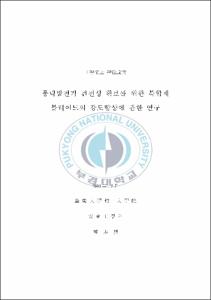풍력발전기 건전성 확보를 위한 복합재 블레이드의 강도향상에 관한 연구
- Abstract
- Recently the modern society has some problems by the exhaustion of the energy source because of using fossil energy such as the coal, oil, natural gas, and etc. Therefore the development of the renewable energy which is sustainable and is clean is obligatorily accompanied.
Our country where is surrounded by sea on 3sides has advantageous location condition for the wind turbine system. The structure of the wind turbine system is composed of the blade, nacelle, and tower. The blade is composed of much technology, it is the most exposed to the danger of accident and if the accident happens, it would be the most dangerous part because it revolves at high speed. Especially, the study on the strength improvement of the blade is essential to the actual condition in which the external environment suddenly change due to the global warming. Therefore, the object of this study secures the safety of the wind turbine system through the strength improvement of the blade. The Flap-Wise Test condition that is the essential structural performance test of the blade is given and it tries to compare with the existing blade model after finding the material characteristic value of the CFRP through the tension experiment prior to the evaluation of an analysis. Finite element analysis for structural strength improvement of blade was carried out using the commercial ANSYS code.
The following conclusions could be drawn from this study.
1) The stress-strain curve resulting from the material characteristic evaluation showed the linearly steady relation until the fracture and it could confirm the superiority of the material through the obtained mechanical characteristic.
2) The stress distribution under the Flap-wise test condition is regular and low stress value by load burden of replaced CFRP layer among the internal structural materials in comparison with GFRP model. In addition, in the twisted tip part, the stress value which is lower than GFRP model was shown and the structural performance improvement could be confirmed.
3) The model replaced by plain woven CFRP confirmed that displacement was markedly decreased in comparison with GFRP model and it controls the deformation of the blade. The CFRP model which is proved the strength improvement is considered additional lightweight by reducing the thickness of section of CFRP model since performing the analysis about the model having the same thickness of section of the models.
4) The models showed the high stress value in the Hub and Neck connection part. In the case of broadening the application to connection part based on the analysis result, it is considered that the reinforcement about Hub and Neck connection part can be improved.
- Issued Date
- 2011
- Awarded Date
- 2011. 8
- Type
- Dissertation
- Publisher
- 부경대학교
- Department
- 대학원 안전공학과
- Advisor
- 권오헌
- Table Of Contents
- l.서론 1
ll.기본내용 4
1.1 풍력발전 블레이드 4
1.2 풍력발전 사고원인 8
1.3 탄소섬유 강화 플라스틱 11
lll. 실험 및 해석조건 14
1.1 재료특성평가 실험설계 14
1.1.1 실험재료 및 시험편 14
1.1.2 실험방법 18
1.2 복합재 블레이드 강도해석 19
1.2.1 Flap wise test 해석모델 19
1.2.2 Flap wise test 해석조건 22
lV. 결과 및 고찰 24
1.1 재료특성치 결과 24
1.2 Minimum flap wise test 결과 26
1.3 Maximum flap wise test 결과 33
V. 결론 40
- Degree
- Master
- Files in This Item:
-
-
Download
 풍력발전기 건전성 확보를 위한 복합재 블레이드의 강도향상에 관한 연구.pdf
기타 데이터 / 2.46 MB / Adobe PDF
풍력발전기 건전성 확보를 위한 복합재 블레이드의 강도향상에 관한 연구.pdf
기타 데이터 / 2.46 MB / Adobe PDF
-
Items in Repository are protected by copyright, with all rights reserved, unless otherwise indicated.